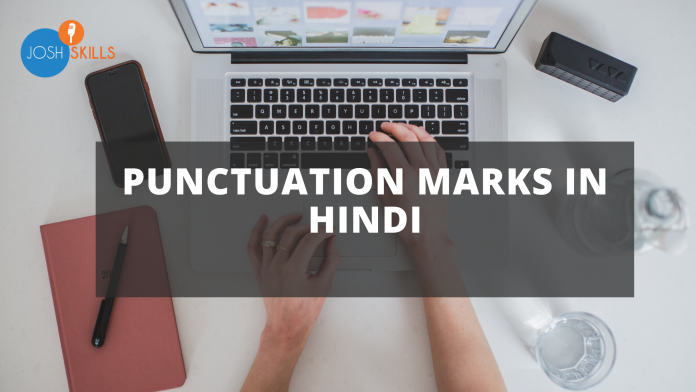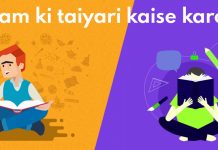
Is article mein hum aapko batayenge Punctuation Marks in Hindi ke baare mai. English language ek aisi language hai jo har kisi ke career aur status ke liye zaruri hoti hai. Isi liye sab individuals English sikhna chahte hai aur seekh bhi rahe hai. Lekin kisi bhi language ko agar hum sahi tarah se bol ya likh nahi paate hai ya sentence mai kahan rukna hai ye dhyan nahi rakhte hai toh hamari English correct nahi hogi aur isse sentence ka meaning change ho jata hai aur aisa hota hai ki hum bolna kuch aur chahte hai aur dusra individual kuch aur hi samajh baithta hai. Ab aap ye soch rahe honge ke is problem ka solution kya hai. Kis tarah se hum English language ko sahi tarah se bol aur likh paaye taake hum jo sentences ke through message dena chahte hai wo sahi tarah se de paaye. Is ka solution hai “Punctuations Marks”.Aaiye jante hai Punctuation Marks in Hindi.
Jaaniye Punctuation Marks In Hindi Ya Interpunction Marks In Hindi?
Punctuations ko “Interpunction” bhi kaha jata hai. Punctuation marks aise marks hote hai jo English writing mai use kiye jaate hai, ye sentences ko separate karte hai aur apne elements ko add karte hai meaning ko clarify karne ke liye. Jaise ke: Full Stop, Comma, Question Mark etc.
Punctuation Marks ki definition ko dekhne ke baad aage badhte hai aur dekthe hai kitne prakar ke hote hai puncuation marks in Hindi.
Kitne Prakar Ke Hote Hai Punctuation Marks In Hindi?
Punctuations 14 types ke hote hai. Aaiye dekhte hai 14 types of Interpunction marks in Hindi.
- The Full Stop .
- The Comma ,
- The Dash __
- The Hyphen –
- The Question Mark ?
- The Exclamation Mark !
- The Inverted Commas “ ”
- The Semicolon ;
- The Colon :
- The Bracket – Parenthesis( )
- The Bracket – Braces { }
- The Bracket – Square Brackets [ ]
- The Apostrophe ’
- The Slash Or Oblique /
Aaiye jante hai in Punctuation Marks in Hindi ko detail mai unke uses ke saath.
- The Full Stop/Period
Sentence, expression ka ek complete thought hota hai. Jab hum baat karte hue ek thought ko complete karte hai, hum kuch seconds ke liye rukte hai aur jab hum usi thought ko likhte hai, toh hum usey end karte hai Full Stop yani ke Period se. Ek sentence utna lengthy ho sakta hai jitna ke likhne ya bolne wale ka thought ho, lekin agar hum sentence mein kahin bhi, usually sentence ke end mein Full Stop / Period lagate hai to iska matlab ye hota hai ke sentence complete ho chuka hai aur ultimately is ka matlab ye hai ki jis thought ko hum express karna chahte hai wo complete ho chuka hai.
Examples
- She is playing Tennis.; Woh Tennis khel rahi hai.
- I am playing with a ball.; Mai ball se khel rahi hu.
- My mother is a good teacher.; Meri mother ek acchi teacher hai.
- It’s raining.; Barish ho rahi hai.
- Please have your dinner.; Please dinner karlein.
- The Comma
Aaiye comma ke usage ke bare mai jaante hai.
- Kisi series ya list mein items to separate karne ke liye comma use kiya jata hai.
Examples
- I have purchased two kilos of mangoes, five kilos of tomatoes and milk; Maine do kilo mango, five kilo tomatoes aur milk khareeda hai.
- Please get me a book, pen and a slate; Please mujhe ek book, pen aur slate laado.
- Radha, Meena and Sam stood first in class; Radha, Meena aur Sam class mein first aaye hai.
- I have been to Haryana, Delhi, Shimla and Ooty; Mai Haryana, Delhi, Shimla aur Ooty gaya tha.
- My mother had cooked dal, rice and roti; Meri mummy ne dal, rice aur roti banai hai.
- Commas, phrases ko separate karne ke liye comma’s use kiye jaate hai.
Examples
- If it doesn’t rain tomorrow, we will go for a picnic; Agar kal barsaat na ho toh, hum picnic par jayenge.
- He searched for the book, but couldn’t find it anywhere; Usne book ki talash ki, lekin usey wo kahin nahi mili.
- He woke up early, but couldn’t reach the office on time; Woh jaldi jaag gaya, lekin time par office nahi pahunch paaya.
- She was running, unfortunately she slipped; Woh bhaag rahi thi, unfortunately woh slip ho gayi.
- She had reached Delhi, but she was late; Woh Delhi pahunch gayi, lekin woh late ho gayi.
- Sentence mein question tags ko separate karne ke liye comma’s ka use kiya jata hai.
Examples
- You get my point, don’t you?; Tumko mera point samajh aa gaya hoga, nahi aaya kya?
- You have failed in your exam, haven’t you?; Tum exam mai fail ho chuke ho, hue ho na?
- She’s a Doctor, isn’t she?; Woh Doctor hai, kya woh nahi hai?
- He isn’t here, is he?; Woh yahan nahi hai, woh hai kya?
- I don’t need to finish this today, do I?; Mujhe aaj isey poora karne ki zaroorat nahi hai, mujhe hai kya?
- Sentence mein certain words ko separate karne ke liye comma’s ka use kiya jata hai, jaise ke: however, moreover, in addition to, in short, in fact, of course, firstly, secondly, etc.
Examples
- It was raining heavily. However, he was determined to cross the river; Bahut tez barish ho rahi thi. Haalanki, woh nirdhaarith tha river cross karne ke liye.
- Diet and exercise will help you lose weight and, moreover, it is good for your health; Diet aur exercise tumko weight lose karne mai help karegi aur, atirikt, ye tumhari health ke liye accha hai.
- In addition to basketball, I’m good at Volleyball. Basketball ke alawa, mai Volleyball mai bhi accha hu.
- In short, he wants to win the race; Sanshep mein, woh race jeetna chahta hai.
- Sentence mein text ke spoken part ko unspoken part se separate karne ke liye comma’s use kiye jaate hai.
Examples
- “This is really interesting,” she exclaimed; “Yeh kaafi interesting hai,” Usne kaha.
- “This sounds terrible,” he whispered; “Yeh terrible sound kar raha hai,” Usne whisper kiya.
- Jab words aur phrases direct address mein use kiye jaate hai, tab comma’s ka use hota hai.
Examples
- “Sir, I’m terribly sorry to be late.”; “Sir, Mai bahut sorry feel kar rahi hun late hone ke liye”.
- “Madam, will you have juice?”; “Madam, kya aap juice lengi?”.
- Kuch words ke baad bhi comma use kiya jata hai. Jaise ke: Yes, No, Oh, Ah etc.
Examples
- Yes, I agree with you; Haan, mai tumse agree karta hu.
- No, I am not going to watch a movie today; Nahi, aaj mai movie nahi dekhunga.
3. The Dash
Dash, comma, colon ya semicolon ki place par use kiya ja sakta hai. Mainly iska usage yeh batane ke liye kiya jata hai ke ek group of words add kiye gaye hai ek previous group mein. Yeh ek afterthought ke baad add hota hai, yani ye batane ke liye ke sentence mein group of words insert kiye gaye hai last minute change ko batane ke liye..
Examples
- The solution─ if it is a deemed solution─ is to get your tenant out of the house, as soon as possible.
Is sentence mai soch batayi ja rahi hai, pehle problem ka solution socha ja raha hai aur kaha ja raha hai ki, solution, phir usme afterthought add kiya ja raha hai , “agar ye deemed solution hai to” phir problem ka solution bataya ja raha hai ye keh kar ke “tenant ko ghar se bahar nikalna chahiye, jitna jaldi ho sake”. Ab aap samajh gaye honge ke dash kya hota hai Punctuation marks in Hindi mein.
4. The Hyphen
Hyphen aur Dash ek jaise dikhayi dete hai. Lekin printed matter mein hyphen, dash se chota hota hai. Aaiye dekhte hai hyphen ko kis liye use kiya jata hai.
- Do words ko join karke ek compound word banane ke liye.
Examples
- Green-room
- Hand-towel
- Tooth-paste
- Mother-in-law
Note karne wali baat ye hai ki, Hyphen ke usage mai koi clear rule ya guideline nahi di gayi hai jo humko help karegi ye decide karne mein ke konse words hypenated hai jo ek single word ki tarah use kiye ja sakte hai. Jaise ke: antifreeze, biannual, dining room, blackbird,
5. The Question Mark
Question mark use hota hai ek punctuation mark ki tarah jo batata hai ke ek direct question poocha gaya hai, ye direct speech mai inverted comma’s ke beech bhi use kiya jata hai ya writing mai passage ke part ki tarah bhi use kiya jata hai.
Examples
- “What do you think I should wear for the party tonight?” asked Seema; “Tum kya sochte ho aaj raat ki party ke liye mai kya pehnu?” Seema ne poocha.
- “Will you have lunch today?”; “Kya tum aaj lunch karoge?”
- “Will you be going there today?”; “Kya tum aaj udhar jaoge?”
Question Mark, Full Stop/Period aur Exclamation Mark ko ‘End Punctuations’ kaha jata hai kyon ke woh sentences ke end mai use hote hai.
6. The Exclamatory Mark in Punctuation Marks In Hindi
Exclamatory mark kisi baat par exclaim karne ke liye use kiya jata hai. Jaise ke: koi dramatic confession, warning, gusse wala expression, joy wala expression etc. Yeh emotion ko convey karne ke liye use kiya jata hai. Aaiye dekhte hai Exclamatory mark kab aur kis tarah use kiya jata hai.
- Kisi strong imperative sentence ke baad.
Examples
- Keep quiet!; Chup raho!
- Stay silent!; Silent raho!
- Walk out!; Bahar nikal jao!
- Un words ke baad jo express karte hai anger, joy, surprise, sorrow etc.
Examples
- What a victory!; Kya jeet hai!
- Oh, that was a terrible accident!; Oh, woh kitna terrible accident tha!
- What a waste of money on these elections!; In elections par kitna paisa waste ho raha hai!
7. The Inverted Commas or the Quotation Marks
Inverted commas reader ko yeh batate hai ke unke beech mein jo bhi sentence hota hai woh direct speech hai. Jab hum speaker ki speech ko reproduce karte hai usi tarah se jis tarah se jo originally bola gaya hai, woh speech inverted comma’s ke beech hogi. Yeh use hote hai un words ko enclose karne ke liye jo special significance rakhte hai writer ke liye.
Examples
- “Let me discuss this with your father first.”; “Mai pehle tumhare father se discuss karunga”
- Rajesh said, “It is easy to understand the Punctuation Marks.”; Rajesh ne kaha“ Punctuation marks samajhna easy hai”
Punctuation marks in Hindi ka ek important type “dash” ko janne ke baad aage badhte hai Semicolon ki oar.
8. The Semicolon
Semicolon, comma se strong hota hai lekin full stop se weak hota hai. Yeh two independent clauses ke beech mai use kiya jata hai jo aapas mein linked hai. Iska main function hai several clauses se bane hue sequence of ideas ko create karna. Usually ye main clauses ko connect karte hai ek single sentence ki tarah.
Example
He checked through the heap of bank statements; he then re-checked the list of suppliers to whom he owed money; beyond all doubt, he was bankrupt!.
Usne bank statements ke heap ko check kiya; phir usne suppliers ki list ko recheck kiya jinko wo paise dena baaki hai; bina kisi doubt ke, wo bankrupt tha!;
9. The Colon
- Colon use kiya jata hai list ko indicate karne ke liye.
Example
The diet includes four main types of food: cereals, leafy vegetables, fruits, and fish; Diet include karti hai four main types ke foods: cereals, leafy vegetables, fruits aur fish.
- Colon use kiya jata hai kisi piece of information ko introduce karne ke liye.
Example
He put his hand in his pocket for his wallet: it wasn’t there; Usne apna haath apni pocket mai
daala wallet ke liye: wo wahan nahi tha.
Brackets
Brackets use kiye jate hai us material ko set off karne ke liye jo closely related nahi hai rest of the sentence se. Yeh usually extra information dete hai.
Example
- The findings of the research (refer to Appendix 2) are quite surprising; Research ke findings (Appendix 2 ko refer kare) kaafi surprising hai.
- Katrina (a hurricane) had a devastating effect on thousands of people; Katrina ( ek tufaan) ne hazaaron logo par devastating effect kar diya.
10. Parentheses (())
Parentheses curved notations hote hai jo use kiye jate hai further thoughts ya qualifying remarks ko contain karne ke liye. Parentheses ko comma’s se replace kiya ja sakta hai bina uske meaning ko change kiye.
Example
John and Jane (who were the speakers on an annual day) both have red hair; John aur Jane (Jo annual day ke speakers they) dono ke baal red hai.
11. Square Brackets [ ]
Square brackets, squared off notations hote hai jo technical explanations ke liye use kiye jate hai.
Example
She said: “If I can’t keep her [her horse], I’ll scream the house down!”
Is sentence mein, square bracket mein jo text hai wo “her” ke baare mein explain kar raha hai.
12. Braces ({})
Braces use kiye jate hai text ke do ya do se zyada lines ya listed items ko contain karne ke liye aur batane ke liye ke wo ek unit hai. Yeh writing mai zyada use nahi kiye jaate lekin yeh computer programming mai zyada dikhayi dete hai, yeh dikhane ke liye ke same lines mai kya contain karna chahiye.
Examples
- She highlighted six numbers {2, 4, 6, 8, 10, 12} on the ruler she made; Usne six numbers highlight kiye hai {2, 4, 6, 8, 10, 12} ruler par jo usne banai hai.
- His behavior changed at pivotal ages {5, 11, 14, 20};Uska behaviour pivotal ages mai change hua hai {5, 11, 14, 20}
- Choose a color {red, white, blue, pink} to paint the wall. Color choose karo {red, white, blue, pink} wall ko paint karne ke liye.
- Which ice cream topping is your favorite {chocolate sauce, sprinkles, caramel, cherries}?; Konsi ice cream ki topping tumhari favourite hai {chocolate sauce, sprinkles, caramel, cherries}?
13. The Apostrophe
- Apostrophe, possession ko indicate karta hai.
Example
- Rahul’s book, Ritu’s mobile (s apostrophe= apostrophe mark + s with singular nouns)
- Boys’ school, students’ union (s apostrophe= apostrophe mark after the s with plurals)
- Yeh letter ke omission ko bhi indicate karne ke liye use kiya jata hai.
- Do not – don’t
- That is – that’s
- It is – it’s
14. The Slash Or Oblique /
Slanting line/stroke ko hum slash ya oblique kehte hai. Yeh writing mein use kiya jata hai exclusive, ya inclusive, division ya fractions, ya date separator ki tarah.
Hum kabhi slash ko period ki tarah bhi use karte hai especially poetry likhte samay. Shift of lines usually slash ke use se convey hota hai.
Example
The sun came/spoke of light to me/ the sun gave us fame/
Yeh fraction mein bhi use hota hai,particularly involving large numbers, jaise ke: 67/89.
Backslash \ use kiya jata hai programming / Coding ke liye computer languages mai.
Capital Letters is considered as Interpunction Marks In Hindi
Capital letter ko bhi part of correct punctuation ki tarah consider kiya jata hai.
Usage of Capital Letters as Punctuation Marks In Hindi
- Sentence ko shuru karne ke liye
- Poetry ki fresh line start karne ke liye.
- Proper Nouns aur Adjectives ko begin karne ke liye jo unse derive hue ho. Jaise ke: Delhi, Rama, Africa, African, Shakespeare, Shakespearian.
- Un saare Nouns aur Pronouns ke liye jo Deity ko indicate karte hai. Jaise ke:The Lord, He is the God etc
- Pronoun aur interjection “O” ko likhne ke liye.
Exercises/Worksheet/Activities of Interpunction Marks In Hindi
Choose the correct answer. Sahi answer ko choose kijiye.
1. Punctuation is a system of symbols that we use when _______ a language.
- speaking
- writing
- hearing
2. What are the symbols used in this system called?
- punctuals
- punctuations
- punctuation marks
3. Which are examples of punctuation marks?
commas and full stops
- dollar and pound signs
- plus and minus signs
4. “Full stops” are also called
- periods
- endings
- points
5. Which CANNOT come at the end of a sentence?
- a period
- a colon
- an exclamation mark
6. You must put a space ______ every comma in a sentence.
- before
- around
- after
7. What’s the punctuation mark indicating a question called?
- a question tag
- a question mark
- a question sign
8. Which can be used to express strong feelings in written English?
- an exclamation mark
- a quotation mark
- a backslash
9. Quotation marks are put _______ the words being quoted.
- before
- after
- before and after
10. In British English, ( ) are called “round brackets”, but in American English they’re often called
- round braces
- square brackets
- parentheses
Answers
1. writing
2. punctuation marks
3. commas and full stops
4. periods
5. a colon
6. after
7. a question mark
8. an exclamation mark
9. before and after
10. parentheses
Use appropriate punctuation marks in the following sentences.
1. We had a great time in France the kids really enjoyed it
2. Some people work best in the mornings others do better in the evenings
3. What are you doing next weekend
4. Mother had to go into hospital she had heart problems
5. Did you understand why I was upset
6. It is a fine idea let us hope that it is going to work
7. We will be arriving on Monday morning at least I think so
8. A textbook can be a wall between teacher and class
9. The girls father sat in a corner
10. In the words of Murphy’s Law Anything that can go wrong will go wrong
Answers
1. We had a great time in France – the kids really enjoyed it.
2. Some people work best in the mornings; others do better in the evenings.
3. What are you doing next weekend?
4. Mother had to go into hospital: she had heart problems.
5. Did you understand why I was upset?
6. It is a fine idea; let us hope that it is going to work.
7. We will be arriving on Monday morning – at least, I think so.
8. A textbook can be a ‘wall’ between teacher and class.
9. The girl’s father sat in a corner.
10. In the words of Murphy’s Law: ‘Anything that can go wrong will go wrong.’
Conclusion of Punctuation Marks in Hindi
Ab aap samajh gaye honge ke Punctuation Marks kya hote hai aur inka usage English Grammar mein kis tarah hota hai aur yeh aapki English ko kis tarah se perfect banate hai. Aap hamare Josh Skills App par diye gaye saare articles jo English Grammar par based hai woh padh sakte hai hai. Jaise ke: Noun, Verbs, Adjectives, Prepositions, Present Tense, Past Tense, Future Tense etc. In articles ko padhne se aap ki knowledge badhegi aur saath hi mai aap ko English ka correct usage bhi aajayega. Punctuations mai perfection paane ke liye upar diye gaye exercises attempt kariye aur practice kijiye.
Join Josh Skills Spoken English Course
Judiye 20,000+ logo ko jo Josh ke saath English bolna aur padhna seekh rahe hai. Iss Spoken English Course ko aise design kiya gaya hai, ki koi bhi basic learner iss course se apne theoretical and practical grammar ko improve kar sakta hai. Everyday situations mei english ko kaise most effectively use kiya jaa sakta hai – iss par bhi extra dhyaan diya jaata hai.
Toh aaj hi shuru kare apni learning journey Josh Skills ke courses ke saath.










